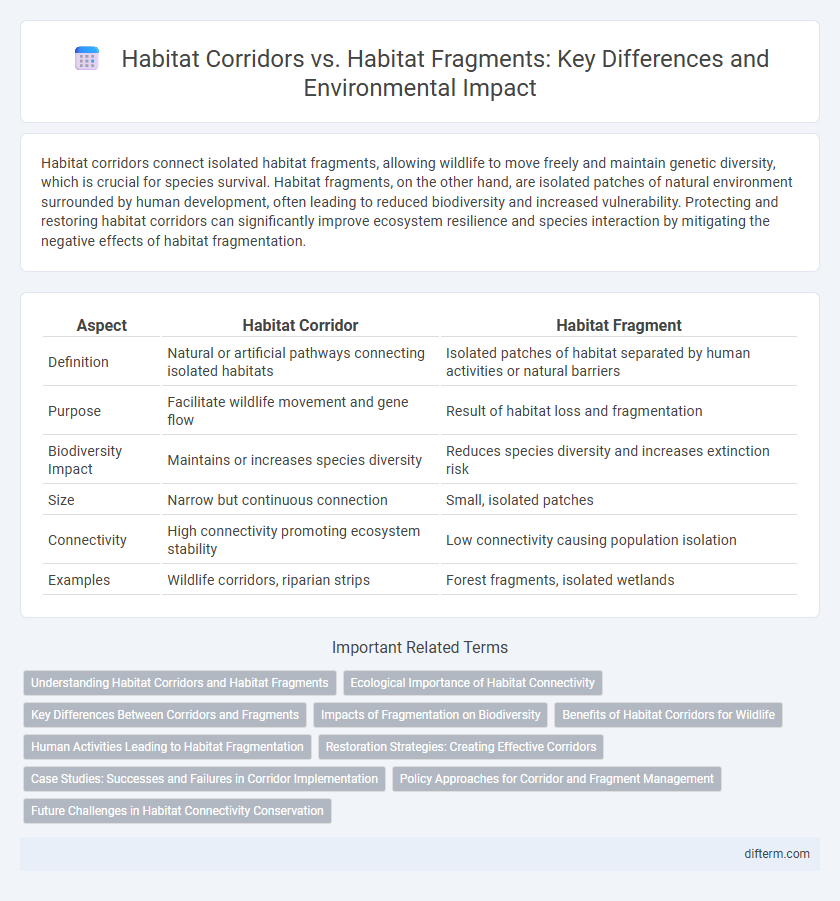Habitat corridors connect isolated habitat fragments, allowing wildlife to move freely and maintain genetic diversity, which is crucial for species survival. Habitat fragments, on the other hand, are isolated patches of natural environment surrounded by human development, often leading to reduced biodiversity and increased vulnerability. Protecting and restoring habitat corridors can significantly improve ecosystem resilience and species interaction by mitigating the negative effects of habitat fragmentation.
Table of Comparison
| Aspect | Habitat Corridor | Habitat Fragment |
|---|---|---|
| Definition | Natural or artificial pathways connecting isolated habitats | Isolated patches of habitat separated by human activities or natural barriers |
| Purpose | Facilitate wildlife movement and gene flow | Result of habitat loss and fragmentation |
| Biodiversity Impact | Maintains or increases species diversity | Reduces species diversity and increases extinction risk |
| Size | Narrow but continuous connection | Small, isolated patches |
| Connectivity | High connectivity promoting ecosystem stability | Low connectivity causing population isolation |
| Examples | Wildlife corridors, riparian strips | Forest fragments, isolated wetlands |
Understanding Habitat Corridors and Habitat Fragments
Habitat corridors are natural or artificial pathways that connect separate wildlife habitats, facilitating species movement and genetic exchange to maintain biodiversity. In contrast, habitat fragments are isolated patches of ecosystems disrupted by human activities or natural processes, often leading to reduced species populations and increased vulnerability. Understanding the dynamics between habitat corridors and fragments is crucial for effective conservation strategies and landscape planning.
Ecological Importance of Habitat Connectivity
Habitat corridors play a critical role in maintaining ecological connectivity by allowing wildlife to move between fragmented habitats, which supports gene flow and reduces the risks of local extinctions. In contrast, habitat fragments often isolate populations, limiting access to resources and leading to decreased biodiversity and ecosystem resilience. Ensuring continuous habitat connectivity enhances species survival, promotes ecosystem stability, and helps mitigate the impacts of habitat fragmentation caused by urbanization and land-use changes.
Key Differences Between Corridors and Fragments
Habitat corridors are continuous strips of natural habitat connecting isolated wildlife populations, promoting genetic diversity and species migration, whereas habitat fragments are isolated patches of habitat surrounded by altered or developed landscapes, often leading to reduced biodiversity and increased edge effects. Corridors facilitate animal movement and ecological processes, mitigating the negative impacts of fragmentation by maintaining landscape connectivity. In contrast, fragments face challenges like limited resources, higher vulnerability to invasive species, and disrupted ecological interactions due to their isolation.
Impacts of Fragmentation on Biodiversity
Habitat corridors play a crucial role in mitigating the impacts of habitat fragmentation by enabling species movement and gene flow between isolated patches, which preserves biodiversity and ecosystem resilience. Fragmented habitats, in contrast, suffer from reduced genetic diversity, increased edge effects, and higher vulnerability to invasive species and local extinctions. Maintaining continuous habitat corridors supports species migration, breeding, and adaptation, thereby enhancing overall biodiversity conservation in fragmented landscapes.
Benefits of Habitat Corridors for Wildlife
Habitat corridors significantly enhance biodiversity by connecting isolated habitat fragments, allowing wildlife to safely migrate, seek resources, and find mates, which reduces inbreeding and local extinctions. These natural pathways facilitate gene flow between separated populations, increasing species resilience to environmental changes and climate shifts. By maintaining ecological connectivity, habitat corridors support ecosystem stability and promote the survival of endangered species in fragmented landscapes.
Human Activities Leading to Habitat Fragmentation
Human activities such as urban development, road construction, and agriculture create habitat fragmentation by dividing continuous ecosystems into smaller, isolated patches, hindering wildlife movement. Habitat corridors serve as crucial linkages that reconnect these fragmented habitats, enabling the migration, breeding, and foraging of species across separated patches. The loss of connectivity due to habitat fragmentation exacerbates biodiversity decline and disrupts ecological processes essential for ecosystem resilience.
Restoration Strategies: Creating Effective Corridors
Restoration strategies emphasize the creation of habitat corridors as vital links that reconnect fragmented ecosystems and enable species migration, gene flow, and biodiversity preservation. Effective corridors incorporate native vegetation, minimize human disturbances, and account for species-specific movement needs to enhance ecological connectivity. Integrating habitat corridors into landscape planning mitigates the negative impacts of habitat fragmentation and supports long-term ecosystem resilience.
Case Studies: Successes and Failures in Corridor Implementation
Case studies reveal that habitat corridors often enhance biodiversity by reconnecting fragmented landscapes, exemplified by the Yellowstone to Yukon initiative which successfully facilitated wildlife movement across extensive terrain. Conversely, failures such as the Green Belt Movement corridor in Kenya highlight challenges like insufficient community involvement and habitat degradation, leading to limited ecological benefits. Effective corridor implementation depends on multi-stakeholder collaboration, adaptive management, and addressing socio-economic factors alongside ecological considerations.
Policy Approaches for Corridor and Fragment Management
Effective policy approaches for habitat corridors emphasize the establishment of continuous ecological networks that facilitate wildlife movement and genetic exchange, often incorporating land-use planning, conservation easements, and protected area connectivity mandates. In contrast, fragmented habitats require targeted management strategies including habitat restoration, creation of stepping stones, and mitigation of anthropogenic barriers to reduce isolation and promote species resilience. Integrating adaptive management with stakeholder collaboration ensures both corridors and fragments support biodiversity conservation within dynamic landscapes.
Future Challenges in Habitat Connectivity Conservation
Habitat corridors face future challenges such as climate change-induced shifts in species ranges, requiring adaptive management to maintain connectivity. Habitat fragments often suffer from increased edge effects and genetic isolation, demanding innovative restoration techniques to enhance gene flow. Balancing land-use pressures with conservation goals remains critical to safeguarding ecological networks and biodiversity resilience.
habitat corridor vs habitat fragment Infographic

 difterm.com
difterm.com